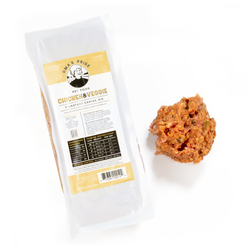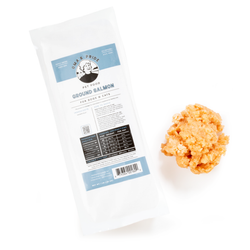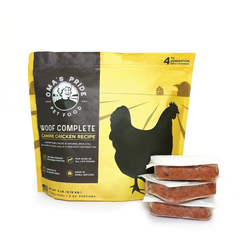Sardines For Dogs? 7 Ways It’s Simply The Best
Did you know that sardines are found in oceans all over the globe? There are also over 21 species of sardines, including the European pilchard.
These plentiful fish travel in large schools and are a nutritious element of people’s diets in many countries. You may be familiar with canned sardines found in the supermarket (preserved in oil or water).
While humans enjoy sardines straight from the can or spread over crackers, cats and dogs benefit greatly from eating raw sardines.
Sardines for dogs provide many benefits for the immune system, joints, coat, eyes, and heart because they are a rich source of omega-3 fatty acids and CoQ10. These small but mighty fish are ideal for canines; they can be fed daily as part of a raw diet (to meet vitamin D and fatty acid requirements) or 3-7 times per week as a kibble topper.
Sardines 101: Basic facts about sardines
Sardines are small, silver-colored fish considered part of the herring family. They only eat phytoplankton, or microscopic algae, and do not consume other animals.
Did you know? Sardines contain less mercury and contaminants than other, larger fish since they only eat plants (algae). This makes them an ideal lower-toxicity fish source for humans, cats, and dogs.
Because sardines are so plentiful around the world, they are a cost-effective option for adding a highly nutritious boost to your dog’s bowl.

Essential vitamins and minerals in sardines
While sardines appear small and unassuming, don’t let this appearance fool you. These small fish are packed with minerals, vitamins, and nutrients to support your dog’s overall longevity and health.
Here are the key vitamins and minerals found in sardines:
- Omega-3 fatty acids. Fatty acids, like EPA and DHA, are found in sardines. Fatty acids are critical for multiple functions, such as heart and brain health.
- Selenium. Sardines are rich in selenium, which is linked to reproduction, immune functioning, and metabolism.
- Calcium and phosphorus. Sardines are a good source of both, which support bone and teeth strength.
- Coenzyme Q10 (CoQ10). This antioxidant assists with cognitive functioning, metabolism, and oxygen utilization.
- Complete protein. Sardines are a complete protein with 9 essential amino acids that dogs need to thrive.
- Copper. Copper is essential for muscular and skeletal health.
- Choline. Choline is vital for brain and liver functioning.
- Vitamins B1, B2, and B3. These key vitamins are important for dogs to assist with skin and coat health, red blood cell production, digestion, and more.
- Vitamin D. Dogs can’t produce this vitamin through sun exposure like humans. Sardines are an excellent source of vitamin D for dogs.
- Cobalamin (vitamin B12). B12 assists enzymes as they play a vital role in processes like digestion.
7 main benefits of sardines for dogs
- A selenium-rich superfood
- Supports healthy joints, bones, and muscles
- Keeps coat shiny and healthy
- Reduces inflammation
- Boosts heart health and cognitive function
- Strengthens retinal health
- Linked to tumor growth inhibition

1. A selenium-rich superfood
Sardines are a food rich in selenium, a trace mineral critical for dogs. For example, sardines in oil have about 49 micrograms of selenium per serving.
Selenium has an antioxidant impact, boosts metabolic function, and plays an important role in the immune system, thyroid, and reproductive health. Dogs deficient in selenium can develop cancer, thyroid disease, and cartilage degeneration in joints (source).
Adding sardines to your dog's bowl provides them with a whole-food, bioavailable source of selenium to help them thrive.
2. Supports healthy joints, bones, and muscles
Sardines are a rich source of omega-3 fatty acids (“healthy fats”), vitamin D, and calcium. All of these play vital nutritional roles in your dog’s body.
For example, omega-3 fatty acids are used to treat dogs with arthritis because they reduce inflammation. Calcium is required for strong bones, teeth, and nails. Additionally, vitamin D balances calcium and phosphorus levels in the body.
3. Keeps coat shiny and healthy
Omega-3 fatty acids found in sardines are essential for keeping skin and coats shiny, soft, and less flaky and itchy.
Did you know? Sardines "provide 2 grams of heart-healthy omega-3s per 3-ounce serving, which is one of the highest levels of omega-3 and lowest levels of mercury of any fish" (Cleveland Clinic).
If you have a dog with intense allergies, hair loss, itchiness, or paw chewing, adding omega-3 fatty acids to their diet is an excellent way to combat these irritations.

4. Reduces inflammation
General or chronic inflammation is bad because it can harm the body and its processes, leading to damage to healthy cells. Unfortunately, many dogs experience osteoarthritis, a type of joint inflammation linked to decreased mobility and intense pain.
Omega-3 fatty acids found in sardines are one of the best ways to reduce inflammation and combat arthritis in your dog’s body.
5. Boosts heart health and cognitive function
Sardines contain coenzyme Q10, which boosts metabolism and supports heart health, oxygen utilization, and cognitive function. CoQ10 is responsible for helping the body convert food into energy. It also acts as an antioxidant.
If you have a puppy, coenzyme Q10 can also help them develop neurologically.
6. Strengthens retinal health
The omega-3 fatty acids in sardines contain both DHA and EPA. DHA is a key element of retinal health and vision. Sadly, many older dogs can experience macular degeneration, cataracts, or glaucoma, all tied to vision.
Adding sardines rich in DHA to your dog’s bowl is a good way to help keep your pup’s vision sharp as they age.
7. Linked to tumor growth inhibition
Omega-3s, selenium, and vitamin D are all extremely powerful elements that work together in sardines. For example:
"Fish oil…rich in omega-3 (n-3) fatty acids, which have been linked to tumor inhibition and strengthening the immune system, fish oil may be more readily absorbed by the dog’s body than a close cousin, flaxseed oil” (Whole Dog Journal).
Sardines are small fish, yet they contain significant concentrations of vital vitamins, minerals, and nutrients essential for long-term and short-term health.
Ways to purchase sardines for your dog
You can purchase sardines for dogs in a few forms. Each form has its pros and cons:
- Canned sardines. You can find canned sardines in almost every grocery store (for human and canine consumption). Canned sardines are convenient and have an extended shelf life. However, they are typically cooked or smoked. Since dogs are canines, they will miss out on raw nutrients in this form. Ensure that you buy sardines in water (not in oil) without spices, flavors, onions, or anything dogs are sensitive to.
- Freeze-dried sardines. You can also buy freeze-dried sardines, which are convenient for travel. Depending on the brand, these should be whole, raw, freeze-dried sardines to retain their nutritional value.
- Raw, fresh, and frozen sardines. Whole raw fresh sardines are the best for dogs because they contain less sodium than canned sardines and aren’t cooked or smoked. While you typically can’t find them at local grocery stores, you can purchase them online (Whole Sardines 1 lb) or from a raw food co-op.
Explore Products
Product feature! Oma's Pride whole raw sardines are a great protein alternative for pets with poultry allergies. These low-mercury fish are safe for daily feeding. They are wild-caught off the coast of California and sourced and produced in the USA. These sardines can be fed to dogs and cats as a meal, treat, or supplement.
Feeding instructions: giving sardines to dogs
As previously mentioned, sardines are an extremely healthy element to include in your pup’s bowl. In a raw diet, feed fatty fish like sardines or mackerel daily to meet vitamin D and fatty acid requirements. As a kibble topper, you can add sardines 3-7 times per week to the bowl.
You can feed sardines as a topper, snack, meal, or treat throughout the week. While you can’t feed sardines exclusively (an imbalanced diet), they can be a consistent part of a balanced diet. A general rule of thumb is that treats should be less than 10% of your pet’s food each day.
While sardines can vary in size, Oma’s Pride Whole Sardines weigh approximately 6 to 8 ounces each and are about 45 calories per ounce. Adjust how much you feed based on your pet's caloric needs, activity level, and size.
As with any new food, start slow when introducing it to your dog’s diet. Watch to see if your pup reacts well, then increase the amount of food over time.
How to serve
- Serving whole raw sardines: Keep them frozen until you’re ready to use them. Thaw them in the refrigerator for 24 hours, then use them within four days. You can cut up the fish or serve them whole. Do not cook them! While you can debone sardines, you don’t have to because dogs and cats are carnivores—they can eat whole fish with bones.
- Serving canned sardines: Drain and rinse the fish before serving to reduce sodium. Sardines have small, soft bones, so you can typically feed them without deboning them first.
What dogs can eat sardines?
As a general rule, dogs that are healthy and at a normal weight can consume sardines (including seniors). Puppies, too, can eat this fish to help develop the heart and brain.
Because sardines are a fattier fish, be careful feeding them to dogs who can’t consume excess fat (for example, those with pancreatitis). Consult your vet if you have specific questions or concerns.
Also, sardines are especially good for picky dogs. The smell, while potentially unappetizing to humans, makes food incredibly delicious for canines.
Bonus: sardine dog treat recipe

If you’re looking to add some excitement to your pup’s bowl, follow these steps to make DIY sardine dog treats:
- Gather your ingredients. You’ll need 1 cup of dog-safe bone broth (no onions or added salt), 1-2 whole sardines (canned or thawed from frozen), and 1 cup of dog-friendly fruit (like bananas, strawberries, blueberries, or apples without seeds or the core).
- Blend it. Place all ingredients in a blender and blend until well mixed into a puree.
- Pour it. Pour the puree into a mold of your choice.
- Freeze and serve. Place the mold into the freezer for at least 2-4 hours, then serve!
Frequently asked questions
Are sardines good for dogs?
Yes, sardines are great for dogs as a part of a balanced diet. Sardines contain omega-3 fatty acids, selenium, and CoQ10 to boost the immune system and metabolism, reduce inflammation, and support the heart, joints, bones, eyes, and skin.
Is it okay to give dogs sardines every day?
Yes, it is okay to give dogs sardines every day when feeding a raw diet to meet daily vitamin D and fatty acid requirements. If you feed kibble, you can add sardines 2-3 times per week to your dog’s bowl as a topper.
Leave a comment
Your email address will not be published. Required fields are marked with *














